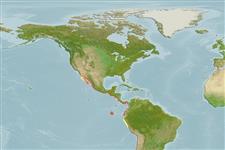Teleostei (teleosts) >
Eupercaria/misc (Various families in series Eupercaria) >
Lutjanidae (Snappers) > Lutjaninae
Etymology: Lutjanus: Malay, ikan lutjan, name of a fish.
More on author: Gill.
Environment: milieu / climate zone / depth range / distribution range
Ecology
Marine; brackish; reef-associated; depth range 0 - 60 m (Ref. 9313), usually 5 - 12 m (Ref. 5227). Tropical; 36°N - 17°S, 121°W - 75°W (Ref. 55)
Eastern Pacific: northern Mexico to northern Peru.
Size / Weight / Age
Maturity: Lm ? range ? - ? cm
Max length : 170 cm TL male/unsexed; (Ref. 9313); max. published weight: 35.7 kg (Ref. 4699)
Dorsal spines (total): 10; Dorsal soft rays (total): 13 - 14; Anal spines: 3; Anal soft rays: 8. Snout rounded, preopercular notch and knob moderate or weak. Scale rows on back rising obliquely above lateral line, rows occasionally horizontal in juveniles. Scale rows on cheek 5 or 6. Back and side dark olive brown to copper-red, becoming whitish ventrally. Young with 9 dark cross-bars; margin of spinous dorsal and most of anal fin black.
Adults inhabit coastal rocky and coral reefs up to at least 60 m depth (Ref. 9313). Juveniles may be encountered in estuaries with mangroves and mouths of rivers (Ref. 9313). Carnivorous, feed on big invertebrates (such as crabs, prawns and shrimps) and fish (Ref. 9313). Marketed fresh or frozen (Ref. 9313).
Life cycle and mating behavior
Maturity | Reproduction | Spawning | Eggs | Fecundity | Larvae
Allen, G.R., 1985. FAO Species Catalogue. Vol. 6. Snappers of the world. An annotated and illustrated catalogue of lutjanid species known to date. FAO Fish. Synop. 125(6):208 p. Rome: FAO. (Ref. 55)
IUCN Red List Status (Ref. 130435: Version 2024-1)
Threat to humans
Harmless
Human uses
Fisheries: commercial; gamefish: yes
Tools
Special reports
Download XML
Internet sources
Estimates based on models
Preferred temperature (Ref.
123201): 22.4 - 29.1, mean 26.7 °C (based on 228 cells).
Phylogenetic diversity index (Ref.
82804): PD
50 = 0.5000 [Uniqueness, from 0.5 = low to 2.0 = high].
Bayesian length-weight: a=0.01514 (0.01324 - 0.01731), b=2.96 (2.93 - 2.99), in cm total length, based on LWR estimates for this species (Ref.
93245).
Trophic level (Ref.
69278): 4.1 ±0.72 se; based on food items.
Resilience (Ref.
120179): Very Low, minimum population doubling time more than 14 years (Preliminary K or Fecundity.).
Fishing Vulnerability (Ref.
59153): Very high vulnerability (90 of 100).
Nutrients (Ref.
124155): Calcium = 14.9 [8.1, 24.1] mg/100g; Iron = 0.265 [0.161, 0.448] mg/100g; Protein = 18.8 [17.2, 20.2] %; Omega3 = 0.11 [0.07, 0.17] g/100g; Selenium = 75.5 [40.6, 134.0] μg/100g; VitaminA = 122 [21, 521] μg/100g; Zinc = 0.367 [0.272, 0.518] mg/100g (wet weight);
